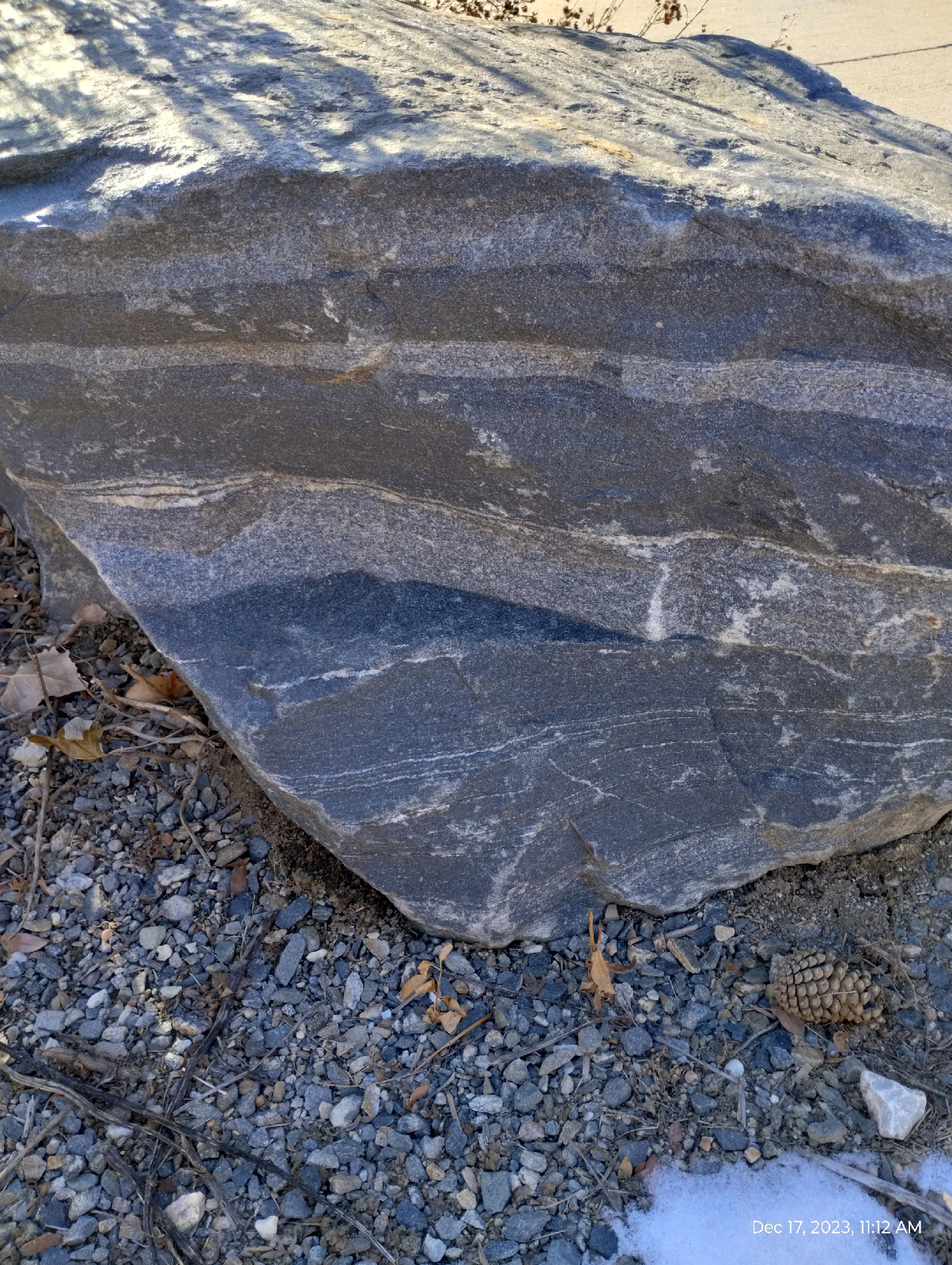These rocks aren't from around here.
We don't have many rocks of any size on the ground in my neighborhood that is "from around here." Rockd describes the rock in this area as "colluvium" "generally unconsolidated material deposited on slopes by gravity and sheetwash." It goes down at least 1.5 meters. Little Dry Creek cuts down to a more consolidated bedrock of gravel, sand, silt, and clay called Post-Piney Creek and Piney Creek alluvium. Somewhere down there is the Dawson, Arapahoe, and Denver formations composed of sand and mudstone and shale. It surfaces occasionally to provide the local aquifer.
Nope, no rocks around here.
Except construction material which does provide the budding geologist with samples for practicing rock identification.
There is a lot of this stuff around. The University of Colorado in Boulder is practically made of the stuff and there's a lot in the Tech Center and other places around Denver. Lyons sandstone is pretty, tough, clean, and breaks naturally into nice slabs ready for laying. We have several formations with decent sandstone for building and if you learn about them, it's easy to walk around Denver saying, that building is made from sandstone (or basalt, or marble) from the ________ formation in the _________ area. It can be pretty impressive to visiting friends and family. "Wow! You're smart!"
"Eh. Just flash "
Anyway, the parks, and there are many in the Denver area, are loaded with landscaping stone. Here are some photos and what I think they are. I won't tell where they are. Some could become the target of vandals or collectors.
There's a lot of gneiss (pronounced "nice"). They look sorta igneous because they're full of crystals. Gneisses are formed under great pressure and temperature which causes the crystals to grow and align in those dark and light bands. Some of the oldest rocks in Colorado are gneisses, formed before the land that would be Colorado was even a thing. These were the arcs of volcanic islands that crashed into the North American plate to form Colorado.
The light bands are mostly quartz and feldspar. The dark materials are amphiboles and micas.
I'm thinking this is an aplite vein in gneiss or diabase. Aplite has pretty much the same constituents as granite but tends to be finer grained. Diabase is the coarser grained volcanic rock with a similar makeup as basalt.
This big chunk of sandstone has traveled. To the best of my knowledge, the closest deposit that would be old enough to have sea scorpions in it is south of Colorado Springs. I think the cross shape is worm burrows
This is a mixed bag, mostly granite and gneiss. I haven't picked through this stuff but I used to find cool specimens in this kind of crushed rock down South.
Here's a pretty, banded mudstone. Mudstones are soft, barely consolidated sedimentary rocks made of, well, mud. A little more pressure and they turn into shale. With added heat and pressure, chemical and physical changes happen to turn the mud into something else, baked clay similar to ceramics, and they become metamorphic slate.
This is the kind of sandstone that forms most of the bedrock in the Denver area. I don't see a lot of it exposed, probably because it isn't particularly pretty. It gets covered over in construction and landscaping projects.
Arcose sandstone is sedimentary rock from eroded granite that still contains many of the minerals unchanged. You can still see grains of quartz and feldspar that hasn't gone to sand and clay. There might even be micas and amphiboles giving it sparkly or darker specks. It forms when weathered products are quickly washed out of the land and buried so that chemical weathering doesn't get a chance to alter it. It's a quickly made sandstone.
The Denver bedrock is an indication of how young the Rockies are (in geological terms) and how quickly they've been carved out.
White rocks are difficult for me. This one has enough crystalization that I want to call it diorite. Diorite is basically a quartz poor granite. I don't see a lot of quartz here but there seems to be mostly chunky feldspar.
It looks like an old boulder. Minerals that contain transition metal ions like iron tend to chemically alter early on and the rusty stains on these rocks are probably from biotite or amphiboles in the original stone.
Much of the "granite" in the Rockies is actually granidiorite, a rock midway between granite and diorite.
So, if you're a budding geologist, don't despise the lowly landscaping stones in your neighbor's garden. Get permission first, and then use them to sharpen your rock identification skills.
Hint: if you run into a problem, you might be able to take a picture and use one of the image identification apps like Google Lens to search for similar images on the Internet.














No comments:
Post a Comment